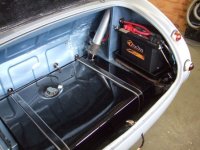Keoke
Great Pumpkin
Offline
To simply protect against this type short-requies that a high amperage aircraft type circuit breaker be installed in the short ground return lead between the cut off switch and the chassis ground in the boot.
Additionally, and also quite simple to implement is to install a battery with the terminal posts located on the opposite side which places the terminals away from the hold down bar- works a treat.
Keeping the battery connections sorted can be done by obtaining those little green - and red + felt washers that fit around the battery terminals underneath the bolt on connectors.
Additionally, and also quite simple to implement is to install a battery with the terminal posts located on the opposite side which places the terminals away from the hold down bar- works a treat.
Keeping the battery connections sorted can be done by obtaining those little green - and red + felt washers that fit around the battery terminals underneath the bolt on connectors.

 Hi Guest!
Hi Guest!

 smilie in place of the real @
smilie in place of the real @
 Pretty Please - add it to our Events forum(s) and add to the calendar! >>
Pretty Please - add it to our Events forum(s) and add to the calendar! >> 




